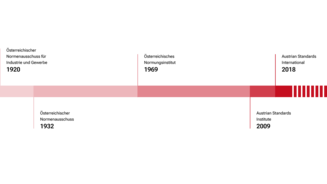
Austrian Standards International
Austrian Standards International – Standardisierung und Innovation is the Austrian standards body according to the Austrian Standards Act 2016. Since 1921, it has offered all those interested in standardisation a neutral, independent platform with uniformly regulated and transparent procedures at international, European and national level.
Association bodies
The Presidential Council is the governing body of the association.
The President's Group is the main technical advisory body of the association.
The General Assembly is made up of the members of the association and is the general decision-making body of the association.
The Director is responsible for managing the association. Dr Valerie Höllinger, MBA, MBL has been Director of the association since January 2022.
The arbitration body decides on all disputes in association matters between members and the association or between members themselves.
History

Österreichische Normenausschuss für Industrie und Gewerbe (Ö.N.I.G.) – the Austrian Standards Committee for Industry and Trade – was founded on 23 September 1920. Standards were developed in 13 technical committees. The focus was on mechanical engineering, electrical engineering and vehicle construction. The first standard appeared in 1921 and regulated metric threads.
1921 was also the year in which Ö.N.I.G. took part in the first (still informal at that time) conference of standards bodies in London. In 1926, Ö.N.I.G. was present at the founding of the ISA – the predecessor to today's ISO.
In 1932, the name Ö.N.I.G. was changed to Österreichischer Normenausschuss (ÖNA). Between 40 and 60 new standards were published each year.
In 1938, ÖNA was dissolved and incorporated into the organisation "DNA Deutscher Normenausschuss" (now known as DIN). ÖNA resumed its work in 1945, as soon as the war ended. Just one year later, it was a founding member of the International Organization for Standardization (ISO).
In 1961, ÖNA become one of the founding members of the European Committee for Standardization (CEN),
and in 1969 the organisation changed its name to ON Österreichisches Normungsinstitut.
The Vienna Agreement between ISO and CEN was signed at the ON headquarters in Vienna in 1991 with the aim of avoiding duplication in Europe. As a result, an increasing number of European and international standards were adopted, some of which replaced ÖNORM standards
, and in summer 2009 the English name Austrian Standards Institute (A.S.I) member of the European Telecommunications Standards Institute (ETSI) in 2016. In 2017, the building at Heinestrasse 38 became the "House of Standards" and the Institute of Electrical and Electronics Engineers (IEEE) opened the European Technology Center there. In 2018, the name was changed to Austrian Standards International – Standardisierung und Innovation.



